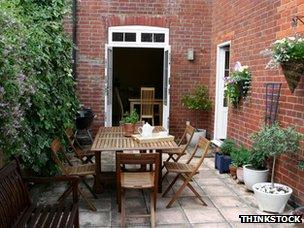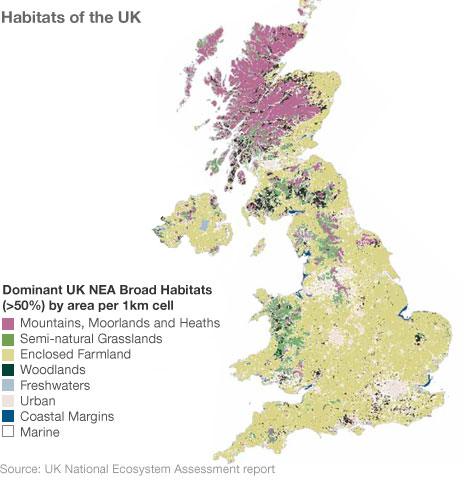The great myth of urban Britain
- Published
- comments

The UK by night, seen from the International Space Station - the bright patches are city lights
What proportion of Britain do you reckon is built on? By that I mean covered by buildings, roads, car parks, railways, paths and so on - what people might call "concreted over". Go on - have a guess.
I was prompted to find out the answer to this question after reading this week how woodland is now calculated to cover 12.7% of the UK, the highest proportion since 1924 when records began.
I tweeted the figures after the ONS published them in their UK Environmental Accounts, external and found I was not the only one surprised. "Do we have a completely mistaken view of what our landscape is like?" I wondered.
The 80% of us who live in towns and cities spend an inordinate amount of time staring at tarmac and brick. On most urban roads, one can be tricked into thinking that the ribbon of grey we see reflects the land use for miles around.
But when you look out of a plane window as you buckle-up ahead of landing at a UK airport, the revelation is how green the country appears.
So what is the answer to my question - have you got a figure in your head?
Until recently, conflicting definitions have made the calculation tricky but fortunately, a huge piece of mapping work was completed last summer - the UK National Ecosystem Assessment, external (NEA).
Five hundred experts analysed vast quantities of data and produced what they claim is the first coherent body of evidence about the state of Britain's natural environment.
Having looked at all the information, they calculated that "6.8% of the UK's land area is now classified as urban" (a definition that includes rural development and roads, by the way).
The urban landscape accounts for 10.6% of England, 1.9% of Scotland, 3.6% of Northern Ireland and 4.1% of Wales.
Put another way, that means almost 93% of the UK is not urban. But even that isn't the end of the story because urban is not the same as built on.
In urban England, for example, the researchers found that just over half the land (54%) in our towns and cities is greenspace - parks, allotments, sports pitches and so on.
Furthermore, domestic gardens account for another 18% of urban land use; rivers, canals, lakes and reservoirs an additional 6.6%.
Their conclusion?
In England, "78.6% of urban areas is designated as natural rather than built". Since urban only covers a tenth of the country, this means that the proportion of England's landscape which is built on is…

Scotland and the North-East embrace paving
… 2.27%.
Yes. According to the most detailed analysis ever conducted, almost 98% of England is, in their word, natural.
Elsewhere in the UK, the figure rises to more than 99%. It is clear that only a small fraction of Britain has been concreted over.
There will be quibbles. What about the gardens people have paved? The NEA looked at that, noting how in London an estimated 3,200 hectares of front gardens have been covered in concrete, bricks or gravel.
Paving levels are highest, it was found, in the North-East of England and Scotland, where 47% and 31% of front gardens are more than three-quarters paved. The detail in their analysis is impressive.
Quite simply, the figures suggest Britain's mental picture of its landscape is far removed from the reality.

This map from the NEA report - also seen on page 20 of the PDF report above - helps to visualise what the country actually looks like.
But even it cannot reflect the extraordinary finding that almost four-fifths of what is designated urban land is not built on.
Perhaps our impressions are the result of lives largely spent in the 2% of the country that has been concreted over - at work, at home or travelling between the two in the car or on the bus.
The lesson might be that we need to celebrate the truth about our green and pleasant land.
Or perhaps it simply tells us we really should get out more.
